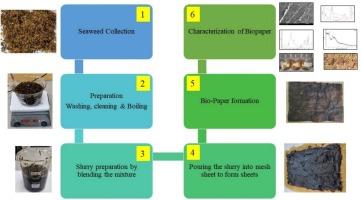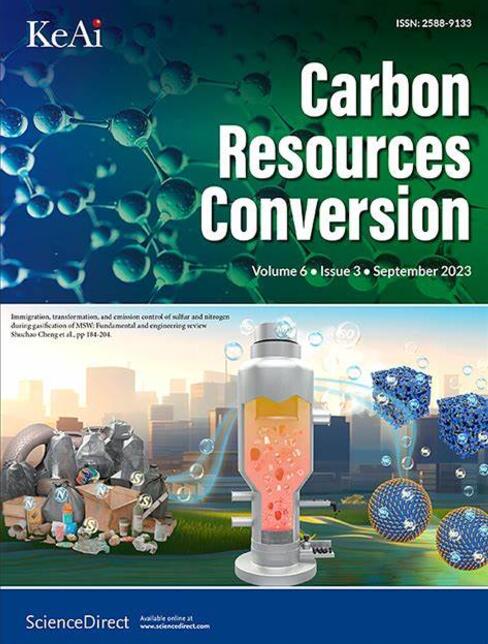Bio-based papers from seaweed and coconut fiber: sustainable materials for a greener future
IF 7.5
3区 环境科学与生态学
Q2 ENERGY & FUELS
引用次数: 0
Abstract
The paper industry’s reliance on deforestation for wood pulp has raised environmental concerns and led to fluctuating prices. This study explores the potential of seaweed (Sargassum wightii) and coconut waste, abundant in Malaysia, as sustainable alternatives for biopaper production. These materials offer a promising solution to mitigate deforestation, address waste issues, and promote sustainable manufacturing. Three biopaper samples were fabricated using 100 % seaweed, 100 % coconut fiber, and a 50/50 blend of seaweed and coconut fiber. The blending of seaweed and coconut fiber allows for customising biopaper properties, such as density and flexibility, making it suitable for a broader range of applications. To characterise these biopapers, scanning electron microscopy (SEM), thermogravimetric analysis (TGA), Fourier-transform infrared spectroscopy (FTIR), and X-ray diffraction (XRD) were employed. Additionally, the grammage (GSM) of each biopaper was determined to compare it with traditional wood pulp-based paper to explore its potential applications. FTIR analysis revealed a wide peak between 3343.47 cm−1 and 3355.75 cm−1 in all samples, confirming the existence of O–H bonds often observed in alcohols. TGA examination at 900 °C demonstrated considerable char production, with the seaweed-based bio paper yielding the most char (26.6 %), followed by the coconut-based paper (15.17 %) and the seaweed-coconut mix (13.49 %). The XRD examination indicates that the structure is largely amorphous, with broad peaks in the 2θ range of 11° to 23°. Water absorption test showed that all biopaper samples were hydrophilic; absorption rates for seaweed-based biopaper were 128 g/m2, coconut-based biopaper was 580 g/m2, and the mix of seaweed and coconut was 446 g/m2. High biodegradability was demonstrated by soil burial tests, which indicated weight reductions of 23 %, 57 %, and 64 % for the blended biopaper, seaweed, and coconut after 14 days, respectively. These results highlight Sargassum wightii’s potential as a sustainable biopaper material. When mixed with coconut fiber waste, it can increase density and broaden its possible applications, providing a viable alternative to wood-based papers while also encouraging environmental sustainability.

海藻和椰子纤维制成的生物基纸:绿色未来的可持续材料
造纸业依赖砍伐森林生产木浆,这引起了人们对环境的担忧,并导致价格波动。本研究探索了马来西亚丰富的海藻(马尾藻)和椰子废料作为生物纸生产的可持续替代品的潜力。这些材料为减轻森林砍伐、解决废物问题和促进可持续制造业提供了一个有希望的解决方案。用100%海藻、100%椰子纤维和50/50海藻和椰子纤维混合制备了三种生物纸样品。海藻和椰子纤维的混合可以定制生物纸的特性,如密度和灵活性,使其适用于更广泛的应用。利用扫描电子显微镜(SEM)、热重分析(TGA)、傅里叶变换红外光谱(FTIR)和x射线衍射(XRD)对这些生物膜进行了表征。此外,确定了每种生物纸的克重(GSM),并将其与传统木浆基纸进行比较,以探索其潜在的应用前景。FTIR分析显示,在所有样品中,3343.47 cm−1和3355.75 cm−1之间有一个宽峰,证实了醇中常见的O-H键的存在。900°C时的TGA测试显示出相当大的碳产量,其中以海藻为基础的生物纸的碳产量最高(26.6%),其次是椰子纸(15.17%)和海藻-椰子混合物(13.49%)。XRD分析表明,该材料在11°~ 23°的2θ范围内具有较宽的峰,结构基本呈非晶态。吸水试验表明,所有生物纸样品均具有亲水性;海藻基生物纸的吸收率为128 g/m2,椰子基生物纸的吸收率为580 g/m2,海藻和椰子的混合吸收率为446 g/m2。土壤掩埋试验表明,高生物降解性表明,混合生物纸、海藻和椰子在14天后分别减轻了23%、57%和64%的重量。这些结果突出了马尾藻作为可持续生物纸材料的潜力。当与椰子纤维废物混合时,它可以增加密度并扩大其可能的应用范围,为木基纸提供可行的替代品,同时也鼓励环境的可持续性。
本文章由计算机程序翻译,如有差异,请以英文原文为准。
求助全文
约1分钟内获得全文
求助全文
来源期刊

Carbon Resources Conversion
Materials Science-Materials Science (miscellaneous)
CiteScore
9.90
自引率
11.70%
发文量
36
审稿时长
10 weeks
期刊介绍:
Carbon Resources Conversion (CRC) publishes fundamental studies and industrial developments regarding relevant technologies aiming for the clean, efficient, value-added, and low-carbon utilization of carbon-containing resources as fuel for energy and as feedstock for materials or chemicals from, for example, fossil fuels, biomass, syngas, CO2, hydrocarbons, and organic wastes via physical, thermal, chemical, biological, and other technical methods. CRC also publishes scientific and engineering studies on resource characterization and pretreatment, carbon material innovation and production, clean technologies related to carbon resource conversion and utilization, and various process-supporting technologies, including on-line or off-line measurement and monitoring, modeling, simulations focused on safe and efficient process operation and control, and process and equipment optimization.
 求助内容:
求助内容: 应助结果提醒方式:
应助结果提醒方式:


